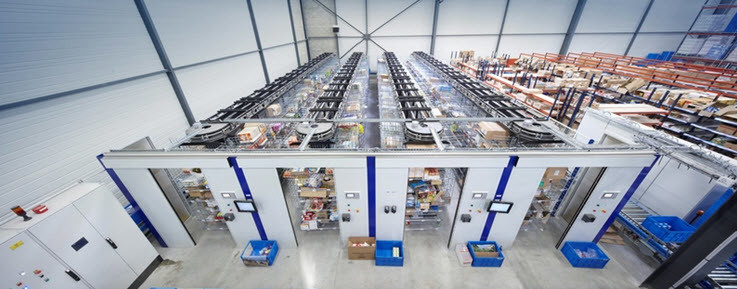Im Zuge des stetig wachsenden Handels steigt bei Unternehmen die Nachfrage nach modernen Kapazitäten zur Lagerung ihrer Produkte. Gleichzeitig wächst der Anspruch an die Lagersysteme, ist doch die effiziente Abwicklung der eingehenden Bestellungen zu einem entscheidenden Wettbewerbsfaktor für die Anbieter geworden.
Auch ist dies ein Bereich, in dem noch enorme Potentiale schlummern, wenn es darum geht, die Produktivität zu steigern. Studien zufolge ist allein der Prozess des Order Pickings für bis zu 55% der anfallenden Gesamtlagerkosten verantwortlich. Hauptgrund dafür ist die Zeit, die die Beschäftigten damit verbringen, die eingelagerten Gegenstände ausfindig zu machen und zur Kommissionierstation zu bringen. Es sind allein diese Transportwege, die knapp zwei Drittel der gesamten Arbeitszeit der Lagerarbeiter auffressen.
Kein Wunder, dass Unternehmen von daher bemüht sind, diesen Aufwand zu minimieren.
Diese Anleitung in 6 Schritten soll Unternehmen dabei helfen, ihre internen Prozesse im Lager hinsichtlich brachliegender Potentiale zu hinterfragen:
- Klassifizierung des Lagerbestands
- Bestand den passenden Regallagerlösungen zuordnen
- Automatisierung der Abläufe
- Identifikation des optimalen Lagerplatzes der Güter
- Optimierung der Picking-Prozesse
- Implementierung einer umfassenden Softwarelösung
1. Klassifizierung des Lagerbestands
Wie genau der Lagerbestand eingeteilt werden soll, hängt von einer Reihe von Faktoren ab. Hauptmerkmale dabei sind Größe und Gewicht der gelagerten Güter sowie ihre Abruffrequenz. Dabei erweist es sich als besonders effizient, ALLE gelagerten Güter zu untersuchen, und sich nicht nur auf die Optimierung der Schnelldreher zu konzentrieren. Die bei Unternehmen häufig als Kriterium ausgemachte 80/20-Regel, nach der 20% der Waren für 80% der Absätze verantwortlich sind, greift hier zu kurz. Denn dies würde bedeuten, dass das Unternehmen im Umkehrschluss 80% der Waren – und damit einen Großteil der Gesamtlagerfläche – im Optimierungsprozess nicht berücksichtigt. Dabei sind es doch besonders die weniger oder selten abgerufenen Güter, die durch ihre weit von den Picking-Stationen entfernten Lagerplätze für die Lagerarbeiter besonders weite Wege und damit Kosten verursachen. Von daher ist es für das Unternehmen ratsam, eine Gesamtlagerlösung für alle vorhandenen Waren zu finden.
2. Bestand den passenden Regallagerlösungen zuordnen
Die Hersteller von Materiallagern bieten dazu eine Vielzahl an Lösungen an, welche sich hinsichtlich ihrer Möglichkeiten, aber auch der Investitionskosten, teilweise beträchtlich voneinander unterscheiden; reichen sie doch von einfachen, manuell zu bedienenden Paletten- und Fachbodenregalen bis hin zu technisch hochentwickelten, vollkommen automatisiert ablaufenden Horizontalkarussellen und vertikalen Lagerliften.
Das einzelne Unternehmen steht nun vor der Aufgabe, für jede Produktgruppe das passende Regalsystem zu identifizieren.
Generell kann man festhalten, dass sich bei vielen Unternehmen (besonders aus dem Bereich E-Commerce) der Einsatz von Palettenregalen für ihre besonders häufig abgerufenen Güter durchgesetzt hat. Dabei ist jedoch einschränkend zu betonen, dass diese Lagerform über einen sehr hohen Platzbedarf verfügt. Geht es um den schnellen Zugriff auf eine Vielzahl an Produkten und ist die Lagerfläche beengt, bieten sich Karussell- oder Hochregallager an, die durch ihre hochverdichtete Bauweise viele Güter auf engem Raum aufnehmen und dazu diese nach dem Prinzip Ware zur Person direkt an den Ort der Kommissionierung transportieren können.
3. Automatisierung der Abläufe
- geringerer Platzbedarf durch Nutzung hochbauender Lager, die die jeweils vorhandenen Deckenhöhen optimal ausnutzen
- höhere Pickgenauigkeit von bis zu 99,9%
- bessere Kontroll- und Steuerungsmöglichkeiten durch Softwaresteuerung
- bessere Bestandsverwaltung – Minder- und Fehlbestände werden schneller erkannt
- Steigerung der Ergonomie am Arbeitsplatz, da die Waren direkt zu den Lagerarbeitern transportiert werden. Die häufig anfallenden Hebe- und Beugebewegungen fallen weg.
4. Identifikation des optimalen Lagerplatzes der Güter
Je besser die diversen Güter eingelagert werden, desto effizienter lässt sich deren Auslagerung bewerkstelligen. Dazu kommt, dass durch geschickte Aufteilung der Waren der benötigte Lagerraum und die Laufwege minimiert werden können. Daneben werden Verbesserungen hinsichtlich
- Abrufzeiten
- Pick-Genauigkeit
- Arbeitsabläufe
- Suchzeiten
erzielt. Um aber die optimale Position jedes einzelnen Produktes im Lager zu finden, werden neben den spezifischen Merkmalen der Waren (Größe, Gewicht, etc.) eine Anzahl zusätzlicher Daten benötigt:
- Abruffrequenz
- Anzahl der jeweils abgerufenen Einheiten
- Anzahl der zu lagernden Einheiten
- produktspezifische Anforderungen an die Lagerung
- Umschlaghäufigkeit
Anhand der gewonnenen Daten ordnet eine Lagerverwaltungssoftware den Gütern dann ihren optimalen Standort zu.
5. Optimierung der Picking-Prozesse
Jetzt, wo die Güter klassifiziert und den passenden Lagersystemen zugeordnet worden sind, geht es darum, den Picking-Prozess zu optimieren. Besonders für den Bereich E-Commerce ist dies von hohem Interesse, da die Kommissionierung der Produkte dort täglich tausendfach vorgenommen wird und sich somit auch schon kleine Verbesserungen deutlich bemerkbar machen können.
Die Bildung von Sammelaufträgen (Batch-Picking) ist ein guter Weg, die Abläufe effizienter zu gestalten. Besonders bei Gütern, die seltener abgerufen werden, ist deren zusammengefasste Abnahme eine hervorragende Möglichkeit zur Zeitersparnis, da der Lagerarbeiter mit einem einzigen Weg so mehrere Aufträge abarbeiten kann.
Daneben besteht mit dem sogenannten Zonen-Picking die Möglichkeit, den Lagerbereich in unterschiedliche Sektionen (Zonen) einzuteilen und diesem einzelne Beschäftigte zuzuordnen. Dort bearbeiten diese die einzelnen Aufträge nur hinsichtlich derjenigen Produkte, welche in der ihnen zugeteilten Zone gelagert werden. Danach wird der Auftrag an die nächste Sektion weitergegeben, aus der wiederum die passenden Güter entnommen werden. Dieses Prinzip der Weitergabe der Aufträge durch die diversen Sektionen eignet sich besonders für Unternehmen, die über Güter verfügen, welche unterschiedliche Abrufraten (hohe und niedrige Pickzahlen) und die aufgrund ihrer Bauart oder Größe divergierende Anforderungen an die Lagersysteme besitzen. Die verschiedenen Systeme können auf diese Weise effizient in einzelnen Zonen aufgebaut werden.
Die Kombination der oberen beiden Strategien ist das parallele Picking. Hier werden die einzelnen Aufträge in allen Zonen parallel bearbeitet und an eine zentrale Station weitergeleitet, wo sie zusammengefasst versandfertig gemacht werden. Dieser Ansatz eignet sich aufgrund seiner komplexen Struktur hauptsächlich für Unternehmen, die täglich mit großen Mengen an abzuarbeitenden Aufträgen und einem umfassenden, diverse Lagersysteme und Zonen erfordernden Bestand operieren.
6. Implementierung einer umfassenden Softwarelösung
Denn nur wenn all die Systeme derart miteinander verbunden sind, dass sie reibungslos miteinander kommunizieren und zentral abrufbar sind, lassen sich die Prozesse im Lager transparent ablichten und effektiv steuern.
Einer erfolgreichen und produktiven Lagerverwaltung steht dann nichts mehr im Wege.


